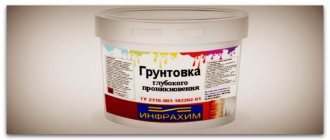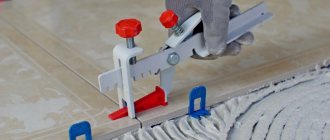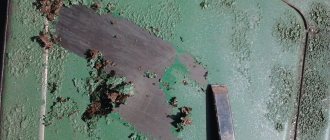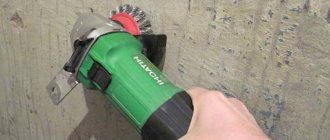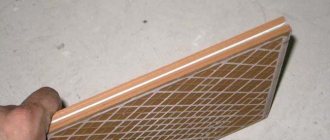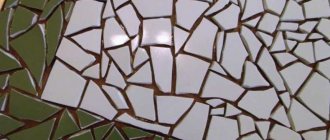Tiles are a popular wall and floor option for kitchens and bathrooms. It has its advantages: high wear resistance, moisture resistance. Such a coating can last for several decades, but the need to remove grout from tile joints often appears earlier. This happens because the seam darkens, becomes clogged with dirt, and cracks. In this case, the old fugue must be carefully removed so as not to damage the tile covering, and then a fresh mixture must be applied.
How to remove old grout?
There are two ways to remove old grout between tiles before laying new ones. In the first case, mechanical action is used with various tools: a knife, a screwdriver, a spatula, a drammel. The second method does not require any effort. When using chemical compounds, the fugue dissolves or softens, and then is easily removed from the space between the tiles.
The use of mechanical force is justified if the fugue used for embedding is cement. Such compounds do not adhere strongly enough to the edge of the tile, so they can be removed even with an ordinary knife. Epoxy, latex and polyurethane mixtures are more difficult to remove, so it is better to dissolve them first. If this recommendation is not followed, there is a risk of accidental damage to the coating.
Briefly about the main thing
Over time, the seams of the tile cladding lose their attractive appearance, and then the old grout is disposed of to replace it with a new one. There are two main ways to clean tiles: chemical and mechanical.
Chemicals are selected taking into account the sealant material, which may have a cement, epoxy or silicone base. The chemical softens the grout, after which it is removed with a knife. The mechanical method involves using a knife (or any other suitable blade) or a power tool. Mechanical removal is best combined with chemical treatment.
Ratings 0
Types of grout
Grouts differ in their composition, but the principle of their operation remains unchanged. The mixture completely fills the joint, attaches to the edges of the tile, forming a durable, moisture-proof partition after hardening.
Attention! It's not worth saving on fugue. Cheap materials do not differ in quality and shrink after application. A good grout contains additives that increase elasticity, due to which the polymer mixture is distributed evenly and cracks do not form on the surface of the hardened material.
Main types of grout:
- cement. Includes cement-polymer and cement-sand fugues. Mixtures of this type are used if the joint width is more than 6 mm. The compositions have an affordable price, but take a long time to polymerize. Drying occurs slowly, which allows you to wipe off fresh grout if it is not distributed correctly. More significant disadvantages: low moisture resistance, cracking, sensitivity to moisture;
- epoxy. Two-component fugue made of resins and fine filler. The product strengthens the seam well, instantly hardens and turns into a moisture-proof mass that resembles plastic in appearance. Epoxy grout can be removed after its polymerization using special solvents. The mechanical method is not recommended due to the risk of damaging the tiles;
- polyurethane. An elastic fugue with high water-repellent properties does not require preliminary dissolution and is sold ready-made. Easily removed from the tile surface. The main disadvantage is that the fugue loses its properties upon contact with chlorine-containing substances, so you will have to wash the tiles with special means;
- latex. Grout with increased plasticity, capable of filling large spaces between tiles (more than 1 cm). It is not used in its pure form due to its high cost. It is used as an additional component for cement mixtures in order to increase resistance to humid environments;
- silicone. Fugue of low quality. Even sanitary and antifungal compounds turn black over time, dry out excessively, and mold forms on them. Removing a product of this type is simple; after a few years it can be easily removed by prying it off with a screwdriver;
- furanic A fugue that is not intended for use in apartments. Such a fugue can release harmful substances and compounds into the air. It is produced only in black and is difficult to find in hardware stores.
After familiarizing yourself with all types of tile grout, you can understand which one is suitable for a particular room. If the area is dry, a simple cement mixture will do. In wet rooms, a latex or polyurethane composition with increased insulating capabilities will last longer.
Preparatory work
Before starting any construction or repair work, you must pay attention to protecting your health. During repairs, the human body is faced with a large amount of dust, exposure of the skin to various materials, many of which cause irritation or an allergic reaction, and small fragments can damage the eyes or other parts of the face. Therefore, before starting work, you should purchase gloves, a respirator, and special glasses. Having completely protected yourself from negative influences, you can start working.
Chemical method
Special chemical solvents are used to remove old grout from tile joints. To remove old fugue effectively, you need to know its composition, because depending on it, the active reagents are selected.
Popular chemicals:
- Valo Clean. It will help clean the tiles from cement grout and remove old, hardened grout. It has a softening effect and is characterized by rapid effectiveness; the result of use appears within a few minutes. After applying the composition, the fugue strip must be pryed with a thin tool and carefully pulled out of the seam;
- Keranet. Powerful composition containing organic acids. This grout dissolving agent works actively with all mixtures, but it must be used carefully. "Keranet" literally eats away the seam. It should not be used on marble or limestone surfaces;
- Litostrip. Helps remove epoxy fugue. It is applied to the seams and wait for the reaction (15-30 minutes). After this, the old grout can be removed from the tiles with a spatula.
After removing the fugue from the seam, the surface of the tile must be washed. There should be no chemical residue left on the edges of the ceramic. New grout can be applied after the surface has completely dried.
Home remedies can help remove old grout from tiles. In terms of efficiency, they are somewhat inferior to professional solvents, but the cost of cleaning will be significantly lower. The following will help remove old mixture from joints:
- concentrated solution of citric acid. 50 g of product should be diluted in 200 ml of water. Using a sponge, apply the liquid to the seam and leave for 12 hours. During this time, the mixture will soften and can be easily removed with a chisel;
- vinegar solution. To prepare the composition, use 9% acid, which is diluted with water 1:1. The liquid is used to wipe the seam. After 10 minutes it can be easily removed;
- aqueous solution of glycerin. Prepare using the following proportion: 3 parts glycerin to 1 part water. The liquid is spread on the seam and then removed with a spatula. It takes at least a day for the reaction to complete.
Advice! Detergents and cleaning agents (liquid) can be used as a solvent. Regular dishwashing liquid or a product that removes lime from plumbing fixtures will do.
Should I delete or not?
The seam between the plates is the weakest link of the ceramic cladding. They lose color, wear out and crack. This happens especially quickly if the technology was violated during installation. It doesn’t matter whether the tiles are on the wall or on the floor, the grout material gradually loses color, turns black, and sometimes becomes moldy. There may be several reasons for this:
- The composition was initially selected without taking into account operating conditions.
- Preparation of a solution in non-compliance with the proportions recommended by the manufacturer.
- Incompetent care of tiles using drugs that destroy the mass filling the space between the plates.
- Lack of effective ventilation in a damp room.
- Uneven seam sealing.
Grout Ceresit CE40 2kg anthracite
388
Buy
Regardless of the cause of the damage, it is impossible to correct the situation and return the surface to its original properties. You need to remove the old layer and lay a new one. This can only be done if the finish can withstand such manipulations.
- Cleaning
Cheat sheet for housewives: how to properly clean different types of tiles
Mechanical methods
The mechanical method involves removing old grout from the tile joints using available tools. It is better to first soften the composition with special substances, then the work will be easier. To clean the grout, you can use a narrow scraper, screwdrivers, drammel and knives. It is better to choose a suitable tool depending on the width of the gap between the edges of the tiles. You must act carefully to prevent chipping.
Painting knife
Old grout can be removed with a paint knife or a utility knife. You need to carefully walk along the edge of the seam several times to break the adhesion. The old fugue should crumble, after which its remains can be removed with another tool. The main thing is to work carefully and slowly, otherwise there is a risk of damaging the tiles.
Seam opener
A grout remover is a special tool for removing grout from seams. Its blade is much thicker than a regular knife, and its entire surface has an abrasive coating. This allows you to remove the seam along its entire length quite quickly. It is enough to go over each seam 1-2 times, and it will crumble. The disadvantage is that it is not very profitable to purchase it for one-time use.
Dremel engraver
The tool is multifunctional and can be used to clean the joints between tiles. For work, use a carbide drill of a suitable diameter and a guide. The latter provides fixation of the drill and prevents slipping. The Dremel allows you to drill through the grout and drill it out. The disadvantage of this method is that it will be difficult for a person without experience to work with a special tool.
Screwdriver
A drill or screwdriver can also be used to remove the grout. For this you need a special attachment - a brush. Cleaning will take place quite quickly, but there is a risk of damage to the coating. Before carrying out work, you need to make sure that the tiles are tightly adhered to the wall and will not collapse. The tool can only be used at low and medium speeds. The brush should be used to work from the corner of the seam, from bottom to top.
Using electrical devices
For beginners, this is the most dangerous method, since there is a high probability of damaging the tiles. For these purposes I use a drill with a small attachment, a grinder, and a screwdriver with a brush attachment. To do this, you must have some experience working with the tool.
To remove old grout using a drill, proceed as follows:
- Select a drill of a smaller diameter, otherwise damage to the tile cannot be avoided;
- The drill is immersed from the edge of the seam, moving it smoothly towards the center, while the device should operate at medium speed;
- Remaining material is removed with a medium-hard brush.
Removing fresh grout
Once the old cracked grout is removed, new material can be used. It is not always possible to install it efficiently and without flaws. Sometimes the master hooks the tile itself, and then the composition can harden on it. There are several methods that allow you to effectively wash tiles and remove streaks and stains.
Attention! You can quickly and effortlessly remove fresh puffer from the ceramic coating with a special spray. It works as a remover and quickly dissolves uncured compounds. The substance must be used immediately after completion of work. You need to buy this product in advance.
Is replacement necessary at all?
At the initial stage of the work, you need to decide how relevant it is to replace the seam. For minor defects and damage, it is possible to use other methods that are less expensive and easy to perform. So, instead of removing it, it is worth considering the following methods of grout restoration:
- Washing seams. With the help of some products you can easily and quickly wash away soot and grease from the fugue. To clean light fugue, it is recommended to use chlorine-containing products. As for colored surfaces, chlorine is contraindicated for them, since under its influence the paint burns out.
- Removing the top layer. In case of surface contamination, fine sandpaper may be used. With its help, you can easily rub over the top layer of the old coating and thereby renew it somewhat.
- Painting. The easiest and most effective way to update grout. To do this, use a special marker and other means.
Experts recommend combining all these methods to achieve maximum effect.
How to clean grout from tiles after renovation?
Cleaning tiles after grouting, when the seam has completely hardened, will help with cleaning agents, but you need to be prepared for their use. Following the instructions guarantees a good result. Main stages:
- Preparation. Wear rubber gloves, goggles and a respirator if caustic agents are used for cleaning. If possible, open a window indoors.
- Application of the solution. The cleaning agent is used spot-on, applying only to contaminated areas. You can use a sponge or brush with unnatural bristles.
- Expectation. Before removing the remaining mixture, you must wait 15-20 minutes for the cleaning composition to react with the fugue.
- Scrubbing. Take a sponge or soft brush and remove the compound from the tiles in a circular motion.
- Rinse the tiles with water to remove any remaining detergent and grout.
Things to consider
Before laying down new grout, it is necessary to take into account all the problems that existed before. So, if the fugue was exposed to fungus, then you first need to clean the seams with an antifungal agent. It is also worth considering the option of using a more modern and durable material.
In any case, if the grout has lost its original appearance, it is very easy to fix. Anyone can re-grout seams without any special skills.
Average score of ratings is more than 0
Share link
Comments There are no comments yet, but you could be the first...
Detergent compositions
Use the available products to help remove unhardened grout from tiles immediately after repairs. Can be used:
- laundry soap. Grate 50 g of brown bar and dissolve in 300 ml of warm water. Apply to the tiles, leave for 5-10 minutes, and then remove the remaining grout;
- baking soda. Moisten the contaminated surface, and then apply a thick paste made from alkali and water to it. You should not wait for a reaction, the abrasive particles of the substance will easily clean the surface, just rub them in;
- ammonia, vinegar and soda. Add 1 tsp to 200 ml of water. soda, pour in 1 tbsp. l. ammonia and vinegar. The product is applied to the contaminated areas pointwise, washed off with a sponge after 10 minutes along with excess grout;
- hydrogen peroxide. Used to wash tiles in their pure form. Moisten a sponge with peroxide and wipe the dirty tiles with it.
Attention! If the grout from the tiles is not immediately removed after repair, the listed remedies may be ineffective. In such cases, it is better to resort to the use of chemical solvents. You can take Atlas Szop, PUFAS CEMENT-EX, Kilto Clean.
Pollution prevention
Over time, the seams between tiles in the bathroom or kitchen become unattractive and lose their original appearance. To prevent this from happening, it is enough to follow the simplest rules for caring for ceramic tiles:
- The grout between the tiles should be periodically treated with soapy water or baking soda once a month.
- Purchase a special waterproofing agent and apply it to the seams after repairs. Thus, the surface of the grout layer will be protected from moisture and dirt for a long time.
- In the bathroom, after taking a shower, you need to turn on the exhaust ventilation. If not, then leave the door open.
- In the kitchen, if grease gets on the seams, you should wipe them off immediately.
- Don’t forget that there is a fungus pencil on sale – it can also come in handy.
Dealing with the appearance of dirt in tile joints is not difficult if preventive measures are carried out in a timely manner. Tile care products will help in this matter. It is not necessary to buy expensive compounds; it is enough to promptly clean the deposits that have appeared with simple solutions based on home recipes. Don’t take it to extremes so that you don’t have to change the grout between the tiles later.
Relief tiles
You can remove grout from the surface of relief tiles using home remedies. It is most convenient to use cleaners that contain acids, for example, a bathroom cleaner. A similar substance is applied to a sponge and distributed over the contaminated surface. The acid will quickly dissolve fresh grout; just remove it with a damp cloth.
Why does grout material deteriorate quickly?
During the service of ceramic tiles, the putty in the joints often loses its characteristics.
During the service of ceramic tiles, the putty in the joints often loses its characteristics
This happens due to several reasons:
- The wrong grout has been selected. It is necessary to select a solution taking into account the purpose of the room, future temperature and humidity.
- Material applied incorrectly. A common mistake is missing places when sealing tile joints with putty or doing it only superficially;
- Incorrect mixing of the solution. The liquid working solution reduces the service life of the grout and the strength of the joints. You must follow the instructions and follow all recommendations of the manufacturer of the composition.
- Incorrect care. Cleaning compounds containing acids react with the components of the mixture and destroy it.
- Mold development. The penetration of bacteria into the space between the tiles causes the destruction of the solution.
- High indoor humidity. Poor ventilation leads to dampness in the bathroom, which damages the tile joints.
- Light seams. Poor quality or untimely cleaning leads to contamination of light-colored seams.
Before cleaning the joints, you need to study its condition and decide how damaged the material is.
- The wrong grout has been selected. It is necessary to select a solution taking into account the purpose of the room, future temperature and humidity.
- Material applied incorrectly. A common mistake is missing places when sealing tile joints with putty or doing it only superficially,
- Incorrect mixing of the solution. The liquid working solution reduces the service life of the grout and the strength of the joints. You must follow the instructions and follow all recommendations of the manufacturer of the composition.
- Incorrect care. Cleaning compounds containing acids react with the components of the mixture and destroy it.
- Mold development. The penetration of bacteria into the space between the tiles causes the destruction of the solution.
- High indoor humidity. Poor ventilation leads to dampness in the bathroom, which damages the tile joints.
- Light seams. Poor quality or untimely cleaning leads to contamination of light-colored seams.
Useful tips
The following recommendations will help reduce the amount of cleaning after the renovation is completed:
- after grouting the seams, you need to wipe each tile with a wet cloth, this will reduce the amount of contamination;
- It is necessary to remove the remains of the fugue immediately after finishing the work, because after polymerization and adhesion to the tile, it will be more difficult to remove stains;
- It is better to cover decorative patterns on the tiles with masking tape, because it is sometimes impossible to remove the sealant that gets into them (if the grooves are too deep);
- When carrying out grouting work in rooms with high humidity, additional ventilation must be provided. If this rule is not followed, the cement composition may not dry out completely and will crumble over time.
It is better to remove grout from the tiles immediately after finishing the repair work. If the mixture has time to completely harden, the effectiveness of the available methods will not be enough, and you will have to buy special products.
Recommendations from experts
Remember, old hardened grout must be removed carefully so as not to damage the front surface of the tile. This can be done either mechanically or chemically, but it is important to choose the right compositions.
For example, substances based on organic acids can be used to remove cement fugues. To combat silicone joint fillers, acidic substances are also used, which soften the composition, making it mushy.
It is important that when removing any type of grout, you must first take care of your own safety and use at least gloves and a mask, because acid preparations have a negative effect on the human body.
